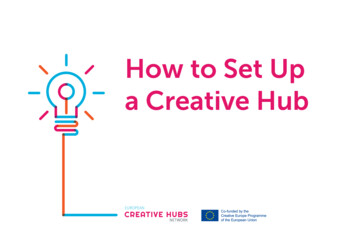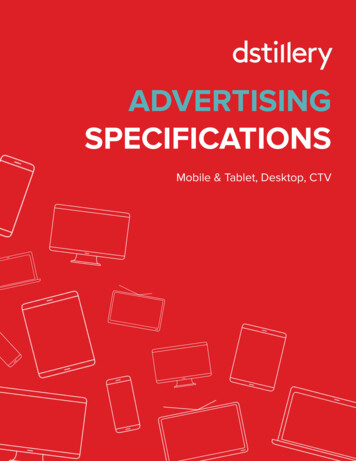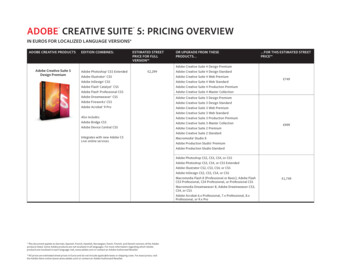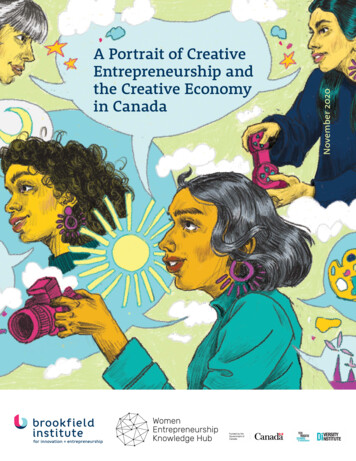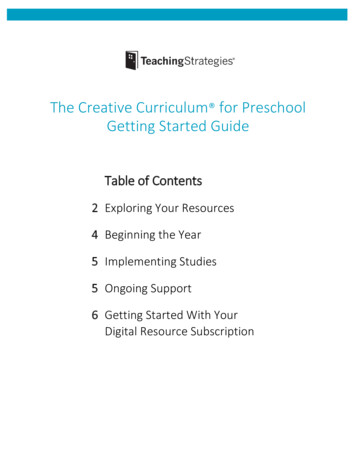
Transcription
Resources for theCreativeCurriculum Reduce ReuseRecycle UnitDCPS Recycles! ProgramD.C. Department of GeneralServices (DGS)About this ResourceThis resource document was created by theDCPS Recycles! program in the D.C. Departmentof General Services (DGS). The intent is toprovide resources and ideas for preschooleducators teaching about recycling within theCreative Curriculum as well as other preschooleducators who would like to teach recycling toyoung students.What is the Creative Curriculum ?The Creative Curriculum for Preschool,developed by Teaching Strategies , is an earlychildhood education curriculum. The curriculumis used in preschool classrooms throughout D.C.Public Schools. The curriculum includes aReduce, Reuse, Recycle Study.dgs.dc.gov/page/dgs-healthy-schoolsJanuary 2016
DGS SUSTAINABILITY ENERGYMore Data. Less Carbon. Zero Excuses.Walk the Talk: Start or Improve your School’sRecycling ProgramThe DC Environmental Literacy Plan defines environmentaleducation as comprising three components - knowledge, skillsand attitude.1 Students learn by doing, so actually recycling isan important part of teaching about recycling. Start orimprove your school’s recycling program so your students canput what you are teaching in action! Depending on yourschool’s recycling program status, you can participate,advocate, or innovate:Participate – If a program is in place, DO IT with your studentsand connect it to the Creative Curriculum .Advocate - If a program is NOT in place, START one! Havestudents advocate for the program through drawings, art,letters, etc. If a program is in place, IMPROVE it! For instance,you can improve paper recycling in classrooms by conductingsurveys of bin correctness. (http://dgs.dc.gov/node/882692)Innovate – Do investigations. Rethink, reduce, reuse!Get creative.See DGS – Healthy Schools for more information and each Students Where DCPS Actually Waste GoesPictures speak louder than words. The “DCPS Recycles!Storybook” contains pictures of where waste (organics, mixedrecycling and trash) from D.C. Public Schools actually goes andhow it travels from the school to various facilities. Check it outat DGS-Healthy Schools under Recycling ls.Pictures from the “DCPS Recycles! Storybook”Classroom “Center” ExamplesHouston Elementary School pre-K teachers outfitted theirclassrooms with Creative Curriculum Centers specific torecycling. For example, they outfitted their classrooms with“thrift stores” to teach students about reusing everydayhousehold items. View more pictures of Houston’s 5/albums).Houston Elementary “Thrift Store” Center1DC Environmental Literacy Plan. y-plan1 Resources for Creative Curriculum Recycling Unit
DGS SUSTAINABILITY ENERGYMore Data. Less Carbon. Zero Excuses.WOW Experiences! ExamplesThe Creative Curriculum calls for “Wow! Experiences,”active, real-world experiences for students. Here are someexamples, plus some examples from DGS:Litter Walk. Go on a litter walk with students around schoolgrounds. Instruct the students to point out litter and commenton the different types of materials. For safety reasons, onlyteachers and staff should pick up litter off the ground.Building Walkthrough. Go on a walk around the building withstudents. Notice recycling bins, signage, bags/liners as well asif the correct contents are in the bins. You could also visit thedumpster area. You may even catch a glimpse of a trash orrecycling truck in action! Use the DCPS Recycles! Honor RollCheat Sheet to identify what to look out for during the walkthrough (http://dgs.dc.gov/node/1106337).Invite a Recycling Expert to Class. The custodial staff is a greatresource on recycling. Ask your school custodian to speak withyour students. Alternatively, schedule a date for a member ofthe DCPS Recycles! team to come to your class to talk aboutrecycling. Contact Cara Blumenthal atcara.blumenthal@dc.gov to schedule a date & time.Make Paper in the Classroom. Make recycled paper in theclassroom using paper scraps, a blender, a mold & deckle (ascreen attached to a frame), a plastic storage container,sponge, and other common items. Here are some onlineinstructions: This Instructables how-to guide uses an “apple pallet”which you can get from your school’s per/?ALLSTEPS How to make homepade ehandmade-paper-from-recycled-materials/ Make seed paper: http://climatekids.nasa.gov/seedpaper/D.C. Department of Public Works’Truck Touch Presentation atBurroughs ES about residentialrecycling. This is another example ofa creative Wow! Experience.Ms. Luckey, head custodian atPowell ES, visited with students totalk about recycling in their school.School Without Walls @ Francis Stevens students make recycledpaper with their teacher, Ms. KarinHarrison. For the mold & deckle, sheused a screen material & duct tape.2 Resources for Creative Curriculum Recycling Unit
DGS SUSTAINABILITY ENERGYMore Data. Less Carbon. Zero Excuses.BooksThe Creative Curriculum includes suggested books as part ofthe curriculum. Here are some other books suggestions thatmay be age-appropriate and relevant: Garbage Helps Our Gardens Grow: A Compost Story byLinda GleserComposting: Nature’s Recyclers by Robin KoontzA Green Kid’s Guide to Composting by Richard LayCompost Basics by Mari SchuhOne Plastic Bag: Isatou Ceesay and the RecyclingWomen of the Gambia by Miranda Paul; Visit thebook’s website for teacher es.Movie ClipsAn example of a book to read tochildren about composting: A GreenKid’s Guide to Composting byRichard LayBelow are clips related to reusing, reducing and recyclingwaste from various movies and documentaries: Magic School Bus (Preview) – The class takes a fieldtrip to a recycling plant:https://www.youtube.com/watch?v e7oPnJ8l-b4 Toy Story 3 - “That’s not trash” scene:https://www.youtube.com/watch?v S4GOJyjRx3I Toy Story 3 - Incinerator scene:https://www.youtube.com/watch?v 93JqK32LqW4 Wall-E - Cleaning up litter scene:https://www.youtube.com/watch?v QHH3iSeDBLo Landfill Harmonic - Children in Paraguay create anorchestra using “trash” to make musical instruments.Documentary trailer: www.landfillharmonicmovie.comReal Recycling Videos “Inside the Prince George's Recycling Center (MD)”https://www.youtube.com/results?search query Prince George%27s County Materials Recycling FacilityA video from American Disposal Services, the wastemanagement company that has the contract forArlington County, VA, not D.C. The facility shown isvery similar to the facility where DCPS’s waste Materials Recycling Facility in Elkridge, MD3 Resources for Creative Curriculum Recycling Unit
DGS SUSTAINABILITY ENERGYMore Data. Less Carbon. Zero Excuses.Take a Field TripTake a trip to your schools’ on-site compost bin (if you haveone) or a nearby community garden with a composting bin. Toidentify a compost bin within walking distance to your school,contact Beth Gingold at beth.gingold@dc.gov.You can also take a trip to your school’s dumpster area toshow them where waste goes when it leaves the building.Tours of facilities may be too much for young children, buthere are links if you are interested: Western Branch Composting Facility –To schedule atour, please call 888-214-8687. www.menv.com. PG County Materials Recycling Facility –To schedule atour, please call (301) ling.Outdoor compost bin at TubmanElementaryDonation ResourcesTeach your students about charity and reducing waste byencouraging them to donate old clothes or items from home.Here are some charities that accept donations in the D.C.area: Salvation Army Charity: To donate clothing, furnitureand household items, visit www.satruck.org for details,or call 800.728.7825. Goodwill Industries International: Use the locator tofind the nearest career center, retail store, donationsite, outlet store or headquarters.http://www.goodwill.org/locator/ Interfaith Works Clothing Center: Organize a drivewith your club, congregation, or group. Keep theInterfaith Clothing Center informed of the date(s) andtime(s) of the drive and delivery (or pickup if you havea large enough quantity). Please call ICC with questionsabout volunteering, donations and drives:301.424.3796. 4 Resources for Creative Curriculum Recycling Unit
DGS SUSTAINABILITY ENERGYMore Data. Less Carbon. Zero Excuses.Share Your Ideas!Check out Pinterest pages (not affiliated with DGS), such as thisone: serecycle-creative-curriculum/Use this DGS-created shared Google Doc to share your ideasabout Creative Curriculum “centers,” books, and otherresources or activities related to recycling. (Note: You musthave access to Gmail to use this p sharingThank you!Young recyclers are more likely to become recycling advocatesand leaders. Thank you for all you do to prepare the nextgeneration with the skills they will need in the 21st century!See DGS – Healthy Schools for more information and ideas:http://dgs.dc.gov/page/dgs-healthy-schools.5 Resources for Creative Curriculum Recycling UnitContact Us! Beth Gingold, Schools Conservation CoordinatorD.C. Department of General Services, beth.gingold@dc.gov, 202-727-3587
Books The Creative Curriculum includes suggested books as part of the curriculum. Here are some other books suggestions that may be age-appropriate and relevant: Garbage Helps Our Gardens Grow: A Compost Story by Linda Gleser Composting: Nature's Recyclers by Robin Koontz A Green Kid's Guide to Composting by Richard Lay

